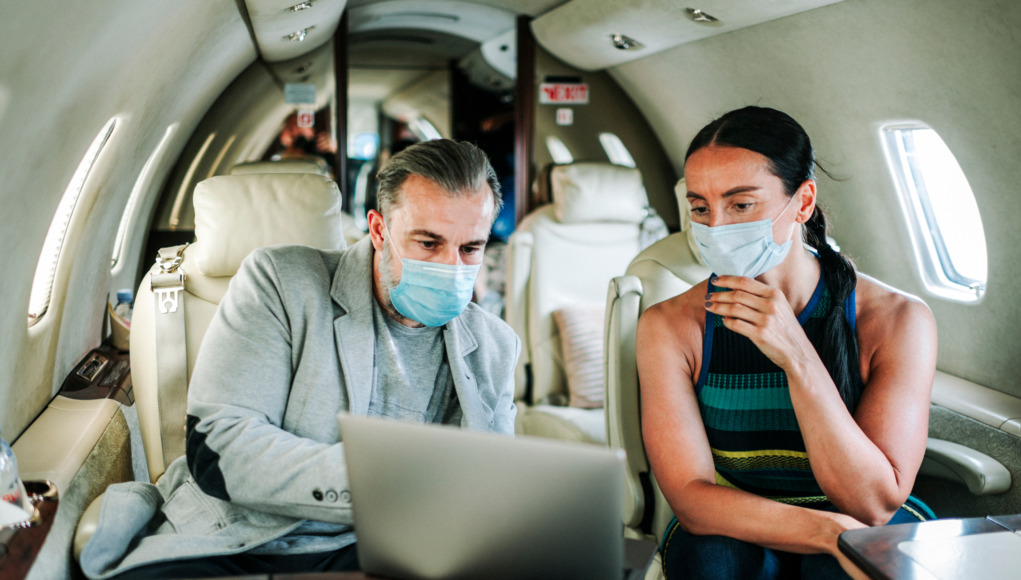The National Aircraft Finance Association (NAFA) recently hosted a webinar with industry leaders: Ed Bolen, President and CEO of the National Business Aviation Association (NBAA); Pete Bunce, President and CEO of the General Aviation Manufacturers Association (GAMA); Tim Obitts, President and CEO of the National Air Transportation Association (NATA); and Mark Baker, President of Aircraft Owners and Pilots Association (AOPA); moderated by Business Aviation Advisor Publisher Gil Wolin to discuss the changing state of the aviation industry.
What are some trends – both positive and negative – that business aircraft owners and users can expect to see?
- General and business aviation use increased dramatically since April, as have first-time jet card buyers and charterers. Initially, 90% of these flights were personal, while only 10% were for business. However, as the year progressed, while the percentage of flight activity for business increased, travel remains challenged because there isn’t a lot of business to be done. According to NBAA, larger international jet traffic is slow. Fortunately, these flight departments have not shut down or sold off their fleet. They are still using their aircraft for intracompany flying between and among remote facilities, while preparing to gear up to resume travel to other cities when it’s safer to do so.
- Health and safety continue to be drivers for increased charter. Ed Bolen cited a recent McKinsey study indicating that travelers flying commercially encountered more than 780 “touchpoints” with others, while those flying business aircraft had fewer than two dozen. For that reason alone most of these new business aviation flyers already say they have no intention of returning to commercial travel. This bodes well for current owners. If your aircraft is available for charter, these new entrants will book more charter hours, helping to maintain or even increase your aircraft’s asset value. History indicates that many of those new charter users will eventually buy their own aircraft, thus bolstering the resale market.
- Baker indicated that flight schools are reporting a dramatic increase in students, from both new flyers and those inactive pilots seeking a refresher. AOPA’s Flying Club initiative, launched in 2016, has to date created 161 clubs, serving more than 2,400 pilots nationwide.
- As the pandemic continues, an interesting new phenomenon has emerged: people are leaving cities for remote suburbs. While they’ve learned to work remotely, they still need mobility. Bunce indicated that the network of GA airports makes that possible, as people are using small aircraft to commute from larger city airports to their new homes.

What are your trade associations doing to support you, and business aviation in general?
- Illegal charter continues to be an issue in the industry. Many owners still do not understand that as soon as money changes hands, that flight can be construed as a commercial flight. NATA has been on the forefront of this issue, along with the FAA, the Department of Homeland Security, and Customs and Border Patrol, educating those who use and operate business aircraft. According to Obitts, it mostly is an issue of dealing with the “clueless and careless.” AOPA is working to inform owners about how to properly share aircraft via safe and legal “dry” (aircraft only) leases.
- After many years of no increases, insurance rate hikes for both new and renewal policies are significant. Insurance underwriters also are discriminating against older pilots, charging higher rates and even denying them coverage. Neither AOPA nor the NTSB has found any correlation between age and fatalities or significant accidents. AOPA is leading industry efforts to fight this age bias by educating insurance providers on the facts, encouraging them to look at individual qualifications, and discussing options like training and level of experience.
In some instances, owners are placing planes in aircraft management companies, while in others, operators are pooling insurance companies to share risk. In all instances, parties are working to understand the real discriminators and to find alternative ways to mitigate risk to the underwriters. Despite these efforts, NATA suggests premiums will likely continue to rise over the next couple of years.
- Safe and efficient business and general aircraft travel depend on access to all airports, especially those with FAA-tower control. NBAA and AOPA work tirelessly to ensure those government-funded towers remain open and functioning, reminding authorities that they fall under the same essential regulatory requirements as interstate highways.
- The one real positive outcome to the pandemic is an increased awareness of, and improvement in, sanitization. NATA created its Safety First Clean Initiative, creating standards for cleaning both aircraft and ground facilities, covering aircraft from landing to departure. FBOs are educating travelers with billboards outlining steps they’ve taken to keep the aircraft and their passenger lounges and maintenance hangars clean. The industry is discovering new uses for ultraviolet and ionizing sanitation procedures, and examining how HEPA filters work to filter cabin air. AOPA’s website, regularly accessed by thousands, is updated daily with a list of restrictions by state. Because of these efforts, all airports remain open today, and these new standards for cleanliness will last long after the pandemic is over.
- The industry continues to invest in the future, ensuring that owners will have the flight and support personnel needed to continue flying safely and securely. Science Technology Engineering & Math (STEM) continues to be an important part of these efforts. AOPA’s donor-supported program has created 400 classes and introduced more than 8,000 children to aviation as a career, 25% of whom are girls and 40% come from diverse backgrounds. GAMA has initiated a Washington, DC program to help introduce inner city students to aviation, as well. NBAA recently conducted a Safety Week, focused on training, technology, and personal fitness.
- To counter ongoing negative public perceptions of business aviation, your trade associations are assertively promoting the usefulness of the industry, advances in sustainable aviation fuel, use of composite technology, and the adoption of GPS. New efforts will celebrate advances in electric, hybrid, and even hydrogen propulsion, as well as aviation technology, such as drones, supersonic travel, Advanced Air Mobility, and particularly Urban Air Mobility – vertical takeoff and landing (VTOL) aircraft.
- Charitable use of aircraft is increasing. In support of pandemic and disaster relief efforts, many companies are donating their aircraft and crews, moving people and supplies to areas that need it most. Bunce stated that aviation manufacturers too are responding generously, diverting their plant capabilities to making much-needed medical and safety equipment to support health care requirements.
This past year has wrought unforeseen changes, for both new and existing users of business and general aviation. We are more aware of the way we travel and conduct business. We now have an increased awareness of the value of time: the cost of time lost or wasted, and how we can travel more safely and efficiently.
That bodes well for both segments in 2021, and beyond. BAA
Tracey Cheek is the Marketing Director of The National Aircraft Finance Association (NAFA), a professional association that has been promoting the general welfare of aircraft finance for nearly 50 years.





